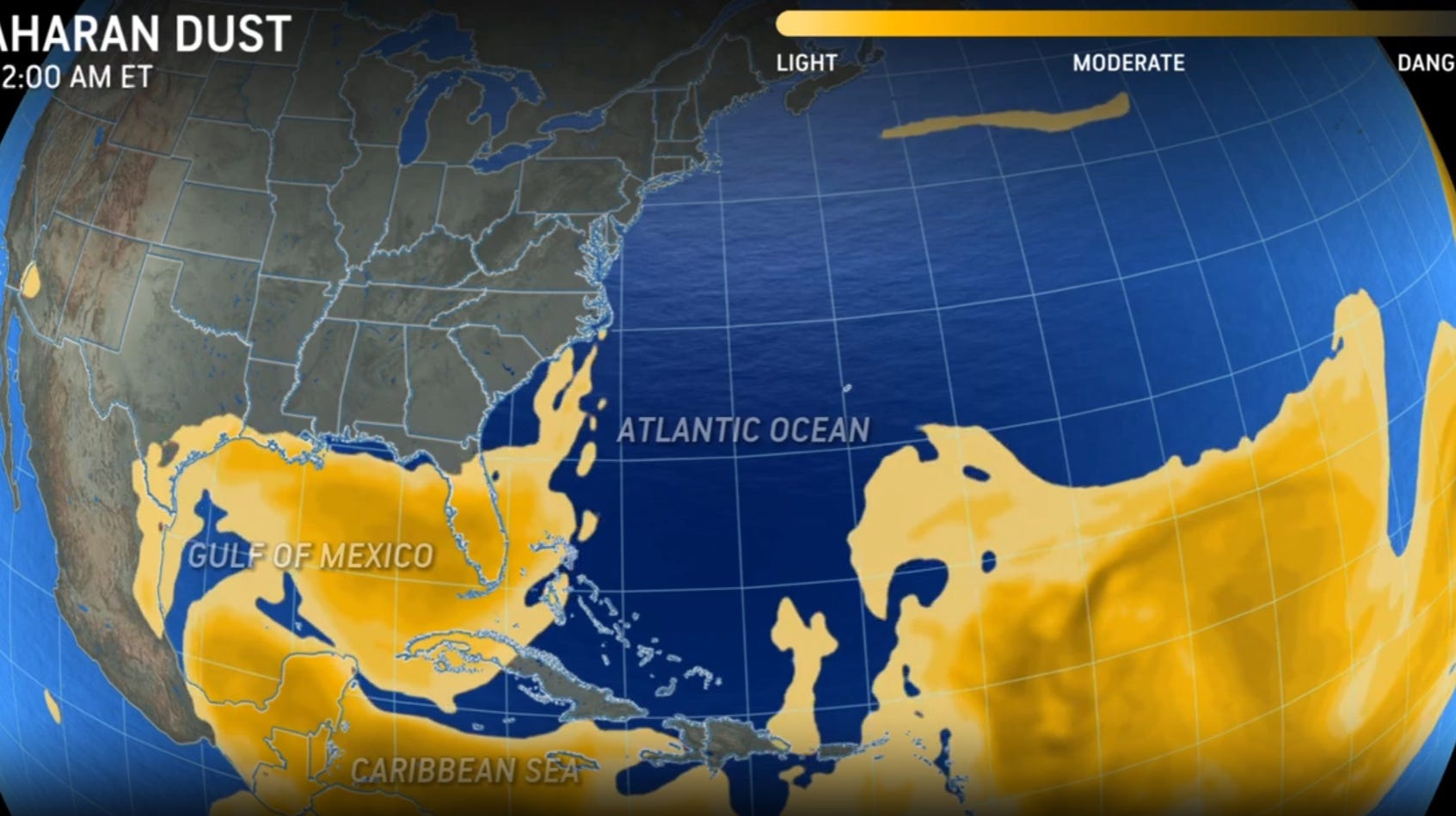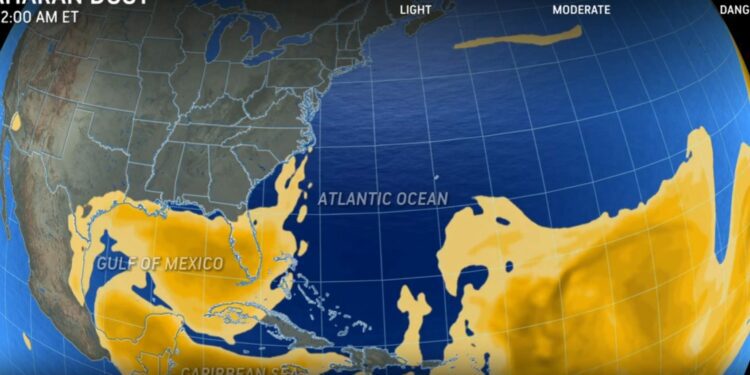
Saharan dust Florida: Dry air helps prevent tropical storms, hurricanes
Saharan dust in the Atlantic helps inhibit the development and strengthening of tropical storms and hurricanes.
Noticing a hazy look to the usually blue Florida skies? That could be dust carried from Africa’s Sahara Desert, making the journey all the way to the states.
The huge plume of Saharan dust, also called the Saharan Air Layer (SAL) by the National Oceanic and Atmospheric Administration, has arrived and has the potential to influence our air quality and weather conditions. Here’s what to know.
What is the Saharan Air Layer?
According to NOAA, the Saharan Air Layer is a mass of very dry, dusty air that forms over the Sahara Desert. It typically forms during the late spring, summer, and early fall, moving over the tropical North Atlantic Ocean every three to five days.
It carries upwards of 66 million tons of dust annually over the ocean and the Americas.
Can you actually see the dust in the air?
Sort of. Given how high in the atmosphere the dust sits, it can create vibrant sunsets and sunrises due to the way it scatters sunlight. During the day, at most, the sky could have a hazy white appearance if there are large enough quantities.
What causes the Sahara Air Layer?
The outbreaks of Saharan dust can form when ripples in the lower-to-middle atmosphere, called tropical waves, track along the southern edge of the Sahara Desert and loft vast amounts of dust into the atmosphere.
As the SAL crosses the Atlantic, it usually occupies an over 2-mile-thick layer of the atmosphere with its base starting about 1 mile above the surface, the NOAA explains. The warmth, dryness, and strong winds associated with the layer have been shown to suppress tropical cyclone formation and intensification.
Is it common for the Saharan dust to cross the Atlantic on a regular basis?
Its activity usually ramps up in mid-June and peaks from late June to mid-August, with new outbreaks occurring every three to five days.
During the peak period, it is common for certain outbreaks to reach farther to the west — as far west as Florida, Central America, and even Texas — and cover extensive areas of the Atlantic (sometimes as large as the lower 48 United States).
How long will Saharan dust last in Florida?
The plumes typically begin in mid-June and run through mid-August; however, WUFT shares the dry air can have lasting effects on hurricane season, which can run through November.
Does Saharan dust make it hotter? Here’s how the Saharan Air Layer influences weather and climate
According to the National Weather Service, there are three characteristics of these “SAL” outbreaks that can affect tropical cyclones, tropical disturbances, and the general climatology of the Atlantic tropical atmosphere:
Extremely Dry Air: The Saharan Air Layer’s dry, dusty air has about 50% less moisture than the typical tropical atmosphere. This extremely dry air can weaken a tropical cyclone or tropical disturbance by promoting downdrafts around the storm.African Easterly Jet: Strong winds in the Saharan Air Layer (25-55 mph or 10-25 meters per second) can substantially increase the vertical wind shear in and around the storm environment. This “mid-level jet” of enhanced winds, typically found at a height of 6,500-14,500 feet (2000-4500 meters), can cause tilting of the tropical cyclone vortex with height and can disrupt the storm’s internal heat engine.Warm Temperatures: The Saharan Air Layer’s warmth acts to stabilize the atmosphere, which can suppress the formation of clouds. This stabilizing effect is produced when the Saharan Air Layer’s warm, buoyant air rides above relatively cooler, denser air. The Saharan Air Layer’s suspended mineral dust also absorbs sunlight, which helps maintain its warmth as it crosses the Atlantic Ocean.What does Saharan dust mean for hurricane season?
It can be seen as good news since we are projected to see a “very active” hurricane season.
Tropical development requires warm water and wind. Tropical disturbances tend to form in waters around the equator where ocean temperatures can reach the 80-degree minimum required to begin developing. When wind moves over these warm bodies of water, it causes water to evaporate from the surface of the ocean.
That vapor then rises, cools and condenses into large water droplets, which create cumulonimbus clouds. When the warm vapor cools, the heat energy is dispersed at the top of the clouds, making the air pressure higher, which in turn pushes the lower air pressure down to the ocean’s surface to repeat the pattern.
The dust helps weaken and suppress tropical cyclone formation and intensification, according to the National Weather Service and NOAA.
Is the dust harmful to our air quality?
Saharan dust can be harmful to health. The Centers for Disease Control and Prevention says the Saharan dust worsens air quality and increases the levels of particulate matter in the air.
The air has about 50% less moisture than the typical atmosphere, which means the presence of the layer can be detrimental to cloud formation and thunderstorm activity.
What are the symptoms of Saharan dust?
The dust particles can be breathed in and enter your lungs and bloodstream, potentially triggering asthma attacks in people who have asthma and aggravating other respiratory conditions. Individuals with seasonal allergies can also be affected by the dust, encountering the typical symptoms of runny noses, sore throats, and itchy eyes.
Saharan dust has been linked to increased emergency department visits for:
AsthmaChronic obstructive pulmonary disease (COPD)Respiratory infectionsHow do I cope with the dust while it’s here?
Dr. David Corry, professor of medicine in the section of immunology, allergy, and rheumatology at Baylor, offers the following tips to be safe while the dust is present:
Stay indoors as much as possible while the dust is in the air or wear a mask while outsideRun a HEPA filter indoors to purify the air, especially in the bedroomPatients who use rescue or controlling medications for pulmonary conditions should have them on hand at all times and use them as prescribedSeek professional medical advice at the first sign of difficulty breathingFor less severe symptoms, standard allergy medications such as antihistamines and steroid nasal sprays might be helpfulIf you are experiencing a sore throat and runny nose and are unsure whether it is COVID, get testedHow can I check the air quality in my region?
Air Quality Index – Current Conditions
Contributing: Brandon Girod, Pensacola News Journal
Source link : https://www.tcpalm.com/story/news/2024/07/10/saharan-dust-air-layer-florida-weather-hurricane-air-quality/74349853007/
Author :
Publish date : 2024-07-10 12:40:58
Copyright for syndicated content belongs to the linked Source.



